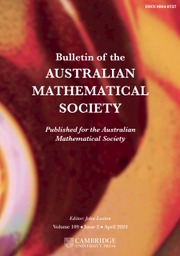No CrossRef data available.
Article contents
A convergence property of Dubins' representation of distributions
Published online by Cambridge University Press: 17 April 2009
Abstract
Core share and HTML view are not available for this content. However, as you have access to this content, a full PDF is available via the ‘Save PDF’ action button.
Let (Xn)n≥1 be a sequence of random variables with zero means and uniformly bounded variences. Let τn be the stopping time defined on a given Brownian motion (Bt)t≥0, B0 = 0, by Dubins' method such that B(τn) has the same distribution as Xn. We prove that Xn converging to 0 in distribution implies that τn converges to 0 in probability. Examples are presented to illustrate the result is the best possible.
Information
- Type
- Research Article
- Information
- Copyright
- Copyright © Australian Mathematical Society 1988
References
[1]Azéma, J. and Yor, M., ‘Une solution simple au probléme de Skorohod’, Sém. Prob XIII, Lecture Notes in Math 721 (1979), 90–115.Google Scholar
[2]Bass, R. F., ‘Skorohod imbedding via stochastic integrals’, Sém. Prob. XVII, Lecture Notes in Math. 986 (1983), 221–224.Google Scholar
[3]Chacon, R.V. and Walsh, J.B., ‘One-dimensional potential embedding’, Sém. Prob. X, Lecture Notes in Math. 511 (1976), 19–23.Google Scholar
[4]Dubins, L.E., ‘On a theorem of Skorohod’, Ann. Math. Statist. 39 (1968), 2094–2097.CrossRefGoogle Scholar
[5]Loynes, R.M., ‘Stopping times on Brownian motion: some properties of Root's construction’, Z. Wahrsch. verw. Gebiete 16 (1970), 211–218.CrossRefGoogle Scholar
[6]Root, D.H., ‘The existence of certain stopping times on Brownian motion’, Ann. Math. Statist. 40 (1967), 715–718.CrossRefGoogle Scholar
[7]Sheu, S.S., ‘Representing a distribution by stopping a Brownian motion: Root's construction’, Bull. Austral. Math. Soc. 34 (1986), 427–431.CrossRefGoogle Scholar
[8]Skorohod, A.V., Studies in the Theory of Random Processes (Addison-Wesley, Reading, Mass., 1965).Google Scholar
[9]Vallois, P., ‘Le problème de Skorohod sur R: une approche avec le temps local’, Sém. Prob. XVII, Lecture Notes in Math. 986 (1983), 227–239.Google Scholar

